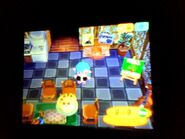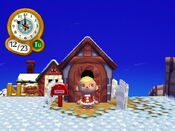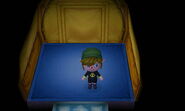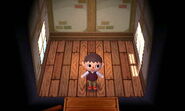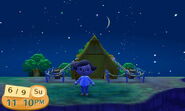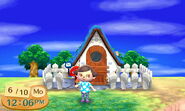The house is the player's central building. At the beginning of each game (Wild World and before), the player purchases their new home from Tom Nook through a mortgage plan. In New Leaf, the player will start off with a tent. Paying off the mortgage generally results in expansions to the house, though they differ from game to game.
The house first appeared in Animal Crossing as part of the Town Square. The town square includes four houses so that four players can live in the same town on one memory card.
The house can be furnished with different types of items. The carpet and wallpaper can be changed out at will, and a custom pattern can be installed on the floor or the wall. The house is expected to be well-furnished by the Happy Room Academy; players are encouraged to collect whole sets, series, and themes of furniture to get a higher score, and possibly the model room at the HRA.
If a player does not play their Animal Crossing series game for some time, they will return to find their house infested with cockroaches. Cockroaches will hide under furniture until it is replaced or moved and then will run all over the floor. The only way the player can get rid of cockroaches is by stepping on them, as opposed to using a net-like when outside since the player can't use nets indoors. In New Leaf, cockroaches will not appear if the town has the ordinance Keep Town Beautiful in effect, no matter how long the player has been away.
Directly outside the front door is the mailbox, where the player can receive mail from other villages or local players.
Parts of the House
In Animal Forest, players are not able to get a second floor or basement.
Tent: In New Leaf, the player begins with a tent. It is nearly exactly the same as the house that cannot be expanded, with a mailbox and windows, except the light switch is not available and the wallpaper and flooring cannot be changed. This restriction cannot be circumvented with Sahara, and such, she will refuse to redecorate the tent. Once the player pays Tom Nook the house down payment, the initial house will be built.
Main Room: This is the first room the house will start with. If the player's house is not a tent, this room can be upgraded several times, have its wallpaper and flooring changed, and in general is the largest room of all expansions.
Second Floor: Introduced in the original Animal Crossing, the second floor is a small room above the main floor, akin to an upstairs bedroom. This room can be furnished in the same way as the main floor.
Basement: Found in all versions but Wild World. The basement was not ranked by the HRA nor could it have its wallpaper or flooring changed until City Folk. In Animal Crossing, it serves mainly as a storage area, due to the lack of the universal storage system introduced in Wild World.
Side Additions: These three rooms are found in Wild World and New Leaf. They are on the ground floor and can be accessed from the main room using doorways on the west, north, and east side of the room.
Attic: In Wild World and City Folk, the initial house also featured an attic. It is always at the top of the staircase. This means initially, it is on the second floor. When the second-floor expansion is purchased, the attic is raised to the third floor. It has the bed, where the player sleeps to save their game, and the Telephone, where the player can change the options of the game. Beds can be changed by the player, while the floor and wallpaper of the attic cannot be changed and no other furniture can be placed in the room.
House Exterior and Location
The location of the player's home varies from game to game, and in some cases features more exterior amenities than other installments.
Animal Crossing
The house exterior in Animal Crossing has some notable exterior flourishes compared to other versions. A sentient object, called a gyroid, sits outside the door. The gyroid can store objects to sell or give away to other players as well as being responsible for saving the game. If the player does not save the game through their gyroid, they will have to deal with Mr. Resetti when they sign in next. The front door can be embellished with a pattern. If the player has caught all 40 fish or insects, a weathervane or butterfly ornament, respectively, will be added to the exterior of the house. A mailbox is present outside the door opposite of the gyroid.
As for exterior styling of the house itself, while the structure cannot be modified the user can paint their roof in 3 ways: house expansion (excluding basement addition), buying paint cans from Nook, or helping Wisp.
The player's house is always located below the Train Station acre in the town square, which hosts up to 4 players.
Animal Crossing: Wild World
Unlike in the previous installment; Wild World features one house that all players share. However, the house later expands into much larger dimensions than the previous games. The mailbox is shared by the players living in the house, but the player can only take out their own mail.
Gyroids are no longer present and have been replaced with an attic. The attic exists in the initial house, furniture cannot be placed in it apart from the beds it comes with, and it only exists as a place for players to "sleep" while they are not playing their character. Similar to the previous title, if the player does not save the game by sleeping in the Attic or using their START button to end the game, Mr. Resetti will visit the player upon their next sign in.
Exterior Styling of the house in Wild World saw the removal of the weathervane and butterfly ornament decorations, as well as the removal of Wisp which limits the player's ability to customize the outside of their home compared to the previous titles. The player can purchase paint from Tom Nook following the first Store Upgrade, and the player will be given the opportunity to change their roof color upon each expansion upgrade.
The house is placed in a random location in the players' town, as determined when the town is first created upon starting the game for the first time.
Animal Crossing: City Folk
City Folk saw the return of houses for each player in the village. The game continues the tradition started by Wild World of having an Attic be the main way of saving the game, apart from the + button.
Exterior Styling of the house remained the same from Wild World with two minor changes. The reintroduction of Wisp saw an additional way to paint the roof of the home outside of visiting Tom Nook after a completed Expansion Payment or buying a paint can following the first Store Upgrade. Finally, following the final upgrade, the player will be given a Flag by Tom Nook to fly outside their house which is fully customizable via the Attic phone.
Each player house is placed in a random location, and the player will be tasked with choosing a home by visiting each one, then talking to Tom Nook once they exit.
Animal Crossing: New Leaf
In a departure from the Wild World formula, the player must go visit Tom Nook to arrange the construction of their home upon first arriving. Nook follows the player around until the player decides on a construction site. Nook will show the player a preview of their completed home and the player is asked for confirmation.
As the construction cannot be performed in one day, Tom Nook lends the player a tent to sleep in at the appointed location of the construction site.
The player may also purchase exterior renovations for their house including paving, siding, fence, door, and mailbox for maximum customization. These are separate from expansions and can be purchased from Nook's Homes. However, as previously mentioned, exterior renovations cannot be applied while expansions are underway, and vice versa.
New Leaf also sees the removal of Mr. Resetti visiting the player if the game is not reset. However, the character does make an appearance after the Reset Center Town Improvement is completed. Mr. Resetti will make one token appearance following the first time the player forgets to save, telling the player of how their Reset Center is no more.
House Interior
The Interior of the house is fully customizable by the player, with the exception of the Basement in Animal Crossing.
Animal Crossing
The lights inside are controlled independently of the furniture in Animal Crossing by pressing the 'Z' button. The storage space was dependent on the number of storage furniture units one had in the house. Each storage unit, such as a bureau, dresser, or cabinet, could hold three items.
Animal Crossing: Wild World
Unlike Animal Crossing, Wild World lighting is controlled by the individual lamps that the player places in the house, allowing some rooms to be illuminated while others remain dark.
Wild World also introduced the Unified Storage System, which links all storage units together with common inventory space, holding up to 90 items. The house also lacks a Basement floor, which makes all rooms in the house fully customizable by the player.
The Attic, also introduced in Wild World, is not customizable by the player outside of allowing the player to change their bed style by using a bed collected by the player and swapping them in their inventory. It's also noted that if the player does not play for a long period of time, the player's hairstyle will be changed to "Bedhead"
Animal Crossing: City Folk
City Folk's lighting system is similar to Wild World's, in that the lighting in the house is controlled by the individual lamps in the home. City Folk also sees the return of the unified storage system, which has been expanded to 160 items as well as the Attic for each player house. All rooms are customizable by the player with the exception of the Attic.
Animal Crossing: New Leaf
New Leaf saw a return to the original method of Lighting control, introducing a universal light switch button on the Touch Screen that controls the lights in the house. The Unified Storage System has been expanded to 180 item capacity and can be readily accessed by the Train Station locker before the player has any storage units in their home.
New Leaf also saw the introduction of a fully 360-degree camera in the home as well as walls being used to hang decoration and furniture.
The Attic was removed in this version, making the START button on the 3DS system the only way the game can be saved by the player, as well as making all rooms customizable by the player.
Expansion

Artwork of a house.
Animal Crossing
In Animal Crossing the house expansion process is paid for by the player to Tom Nook through the Post Office. Upon picking the player's house at the start of the game from the Town Square, Tom Nook will inform the player of the first amount the player must pay back to them.
Each segment of the house expansion process begins immediately after the player talks to Tom Nook following the payment of the previous Expansion's debt.
| Expansion | Cost | Expansion |
|---|---|---|
|
Initial House (16 Squares) |
18,400 Bells |
Ground Floor 16 Squares (Total 16 Squares, 4 by 4 squares) |
|
1st Ground Floor Expansion (36 Squares) |
148,000 Bells |
Ground Floor Expansion +20 Squares (Total 36 Squares, 6 by 6 squares) |
|
Basement Floor Expansion* (64 Squares) |
49,800 Bells |
Basement Floor Addition +64 Squares (Total 64 Squares, 8 by 8 squares) |
|
2nd Ground Floor Expansion* (64 Squares) |
398,000 Bells |
Ground Floor Expansion +28 Squares (Total 64 Squares, 8 by 8 squares) |
|
Second Floor Expansion (36 Squares) |
798,000 Bells |
Second Floor Addition +36 Squares (Total 36 Squares, 6 by 6 Squares) |
* The player may choose to perform either of these upgrades in any order and will be given a choice to start either one first by Tom Nook.
Total Cost: 1,410,800 Bells
Total Floorspace: 164 Squares
Floorspace Cost: 8,602 Bells per Square
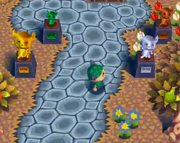
The four trophies in Animal Forest.
After the player's house has been fully upgraded and fully paid off, the player will receive a statue in front of the train station. The first player to do so of the four players will get a gold statue, the second player will get a silver statue, the third player will get a bronze statue, and the fourth will get a jade statue. This feature only appears in Animal Crossing. In Dōbutsu no Mori e+, the player will also receive their own private island.
Animal Crossing: Wild World
Similar to its predecessor, Animal Crossing: Wild World has the player paying Tom Nook for expansions through the Post Office. However, the debt is shared by all players whom live in the house and rather than paying directly to Pelly or Phyllis the player instead pays towards their debt to an ABD machine in the corner of the Post Office.
After paying off the remainder of the previous expansion debt, speaking to Tom Nook will initiate the next expansion. Wild World was the first game in the series to introduce additional rooms on the ground floor, but also lacked any option to choose to start one expansion over another. All Expansions happen in linear order.
Following the end of the last expansion, no reward is granted to the player; unlike previous titles which granted a tangible reward.
| Expansion | Cost | Expansion |
|---|---|---|
|
Initial House (16 Squares) |
19,800 Bells |
Ground Floor 16 Squares (Total 16 Squares, 4 by 4 squares) |
|
1st Ground Floor Expansion (36 Squares) |
120,000 Bells |
Ground Floor Expansion +20 Squares (Total 36 Squares, 6 by 6 squares) |
|
2nd Ground Floor Expansion (64 Squares) |
298,000 Bells |
Ground Floor Expansion +28 Squares (Total 64 Squares, 8 by 8 squares) |
|
Second Floor Expansion (36 Squares) |
598,000 Bells |
Second Floor Addition +36 Squares (Total 36 Squares, 6 by 6 Squares) |
|
Ground Floor Left Room Expansion (36 Squares) |
728,000 Bells | Ground Floor, Left Room Addition
+36 Squares (Total 36 Squares, 6 by 6 Squares) |
|
Ground Floor Right Room Expansion (36 Squares) |
848,000 Bells | Ground Floor, Right Room Addition
+36 Squares (Total 36 Squares, 6 by 6 Squares) |
|
Ground Floor Back Room Expansion (36 Squares) |
948,000 Bells | Ground Floor, Back Room Addition
+36 Squares (Total 36 Squares, 6 by 6 Squares) |
Total Cost: 3,559,800 Bells
Total Floorspace: 208 Squares
Floorspace Cost: 17,114 Bells per Square
Animal Crossing: City Folk
City Folk sees no departure from the formula established in Wild World; however, the concept of additional ground floor rooms is removed and replaced with a revival of the basement floor, which is now fully customizable, unlike its predecessors that featured Basement floors.
City Folk also sees the return of a reward upon completing the final debt payment, receiving a flag outside their house as a free gift from Tom Nook. The design can be changed by calling Rover from the attic using the phone and selecting "Flag Design" from the menu.
Like previous games, each new expansion begins after paying off the previous debt by talking to Tom Nook.
| Expansion | Cost | Expansion |
|---|---|---|
|
Initial House (16 Squares) |
19,800 Bells |
Ground Floor 16 Squares (Total 16 Squares, 4 by 4 squares) |
|
1st Ground Floor Expansion (36 Squares) |
120,000 Bells |
Ground Floor Expansion +20 Squares (Total 36 Squares, 6 by 6 squares) |
|
2nd Ground Floor Expansion (64 Squares) |
248,000 Bells |
Ground Floor Expansion +28 Squares (Total 64 Squares, 8 by 8 squares) |
|
Second Floor Expansion (36 Squares) |
386,000 Bells |
Second Floor Addition +36 Squares (Total 36 Squares, 6 by 6 Squares) |
|
Basement Expansion (64 Squares) |
598,000 Bells | Basement Addition
+36 Squares (Total 36 Squares, 6 by 6 Squares) |
Total cost: 1,353,800 Bells
Total Floorspace: 164 Squares
Floorspace cost: 8,255 Bells per Square
Visual Depiction of Expansions
| External View | Floor Size |
|---|---|
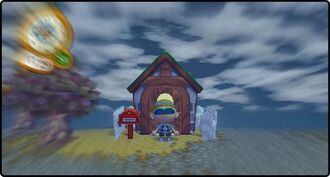 |
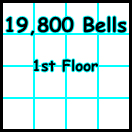 |
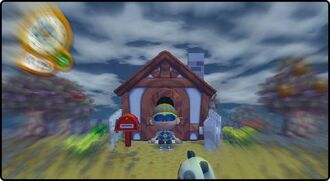 |
 |
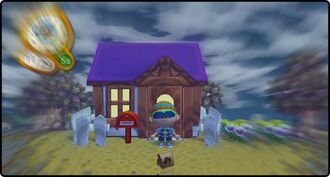 |
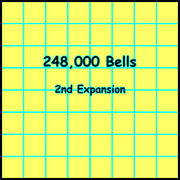 |
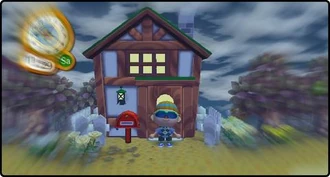 |
 |
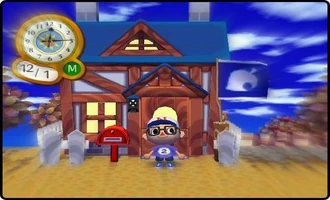 |
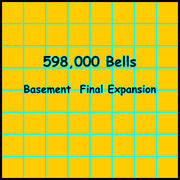 |
Animal Crossing: New Leaf
Unlike in previous games, Expansions must be initiated by the player first. After the Tent is established, the player must return to Tom Nook in order to begin expanding into the Initial House.
The Initial House features a down payment of 10,000 bells must be paid in full directly to Tom Nook before any construction can begin. The 10,000 bells must be paid all at once, directly to Tom Nook, instead of at the Post Office like later payments. Once the home is built, the player will be tasked to pay off the reminder of the debt owed to Tom Nook, which in total has the player paying about 39,800 bells for the expansion.
The Welcome Amiibo update introduced a secret storeroom, which can be purchased from Nook's Homes. This new feature provides a large amount of additional storage space (360 units) which can be accessed from anywhere within the player's home. After a secret storeroom has been purchased, furniture can be arranged using the touch screen as seen in Happy Home Designer. The "room" is an additional button found next to the light switch on the touch screen. It can be added to the house once the initial second floor expansion is paid off. The total cost of the secret storeroom expansion is 158,000 Bells.
Beginning Expansion Tree
Unlike previous games, after repaying the debt to Tom Nook, players are not forced to immediately upgrade. This is because external renovations and house expansions cannot be performed simultaneously, so the player is given the choice to decide which they wish to be completed first.
| Expansion | Cost | Expansion |
|---|---|---|
|
Tent (16 Squares) |
10,000 Bells
In Full |
Ground Floor, Uncustomizable 16 Squares (Total 16 Squares, 4 by 4 squares) |
|
Initial House (16 Squares) |
39,800 Bells |
Initial House Constructed, Customizable +0 Squares (Total 16 Squares, 4 by 4 squares) |
|
1st Ground Floor Expansion (36 Squares) |
98,000 Bells |
Ground Floor Expansion +20 Squares (Total 36 Squares, 6 by 6 squares) |
|
2nd Ground Floor Expansion (64 Squares) |
198,000 Bells |
Ground Floor Expansion +28 Squares (Total 64 Squares, 8 by 8 squares) |
|
Second Floor Expansion (16 Squares) |
298,000 Bells |
Second Floor Addition +16 Squares (Total 16 Squares, 4 by 4 Squares) |
After the second story is constructed, the player may choose to expand existing rooms or construct additional rooms, in any order:
Second Floor Expansion
| Expansion | Cost | Expansion |
|---|---|---|
|
1st Second Floor Expansion (36 Squares) |
498,000 Bells |
Second Floor Expansion +20 Squares (Total 36 Squares, 6 by 6 squares) |
|
2nd Second Floor Expansion (64 Squares) |
598,000 Bells |
Second Floor Expansion +28 Squares (Total 64 Squares, 8 by 8 squares) |
Basement
| Expansion | Cost | Expansion |
|---|---|---|
|
Basement (16 Squares) |
428,000 Bells |
Basement Addition +16 Squares (Total 16 Squares, 4 by 4 squares) |
|
1st Basement Expansion (36 Squares) |
498,000 Bells |
Basement Expansion +20 Squares (Total 36 Squares, 6 by 6 squares) |
|
2nd Basement Expansion (64 Squares) |
598,000 Bells |
Basement Expansion +28 Squares (Total 64 Squares, 8 by 8 squares) |
Ground Floor Left Room
| Expansion | Cost | Expansion |
|---|---|---|
|
Ground Floor Left Room (16 Squares) |
348,000 Bells |
Ground Floor Left Room Addition +16 Squares (Total 16 Squares, 4 by 4 squares) |
|
1st Ground Floor Left Room Expansion (36 Squares) |
498,000 Bells |
Ground Floor Left Room Expansion +20 Squares (Total 36 Squares, 6 by 6 squares) |
|
2nd Ground Floor Left Room Expansion (64 Squares) |
598,000 Bells |
Ground Floor Left Room Expansion +28 Squares (Total 64 Squares, 8 by 8 squares) |
Ground Floor Right Room
| Expansion | Cost | Expansion |
|---|---|---|
|
Ground Floor Right Room (16 Squares) |
348,000 Bells |
Ground Floor Right Room Addition +16 Squares (Total 16 Squares, 4 by 4 squares) |
|
1st Ground Floor Right Room Expansion (36 Squares) |
498,000 Bells |
Ground Floor Right Room Expansion +20 Squares (Total 36 Squares, 6 by 6 squares) |
|
2nd Ground Floor Right Room Expansion (64 Squares) |
598,000 Bells |
Ground Floor Right Room Expansion +28 Squares (Total 64 Squares, 8 by 8 squares) |
Ground Floor Back Room
| Expansion | Cost | Expansion |
|---|---|---|
|
Ground Floor Back Room (16 Squares) |
348,000 Bells |
Ground Floor Back Room Addition +16 Squares (Total 16 Squares, 4 by 4 squares) |
|
1st Ground Floor Back Room Expansion (36 Squares) |
498,000 Bells |
Ground Floor Back Room Expansion +20 Squares (Total 36 Squares, 6 by 6 squares) |
|
2nd Ground Floor Back Room Expansion (64 Squares) |
598,000 Bells |
Ground Floor Back Room Expansion +28 Squares (Total 64 Squares, 8 by 8 squares) |
Total Cost: 7,595,800 Bells Welcome Amiibo Update Total Cost 7,753,800 Bells
Total Floorspace: 320 Squares
Total Wallspace: 142 Squares
Total Furnishable Squares: 462
Floorspace Cost: 23,737 Bells per Square
Tile Cost: 16,441 Bells per Square
Gallery
Animal Crossing
Wild World
City Folk
New Leaf
House Stages
After stage 4, the player is free to decide which part of the house to expand they see fit.
Trivia
- In New Leaf, the first time the player enters their tent, Isabelle will give the player a lantern and explain how to display it.

